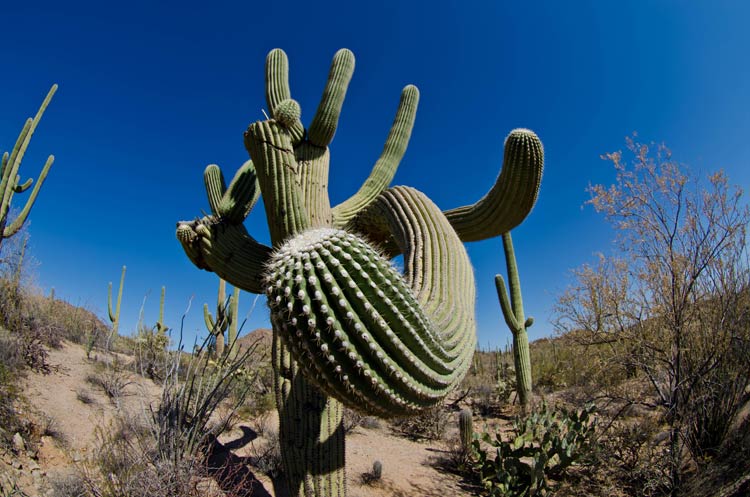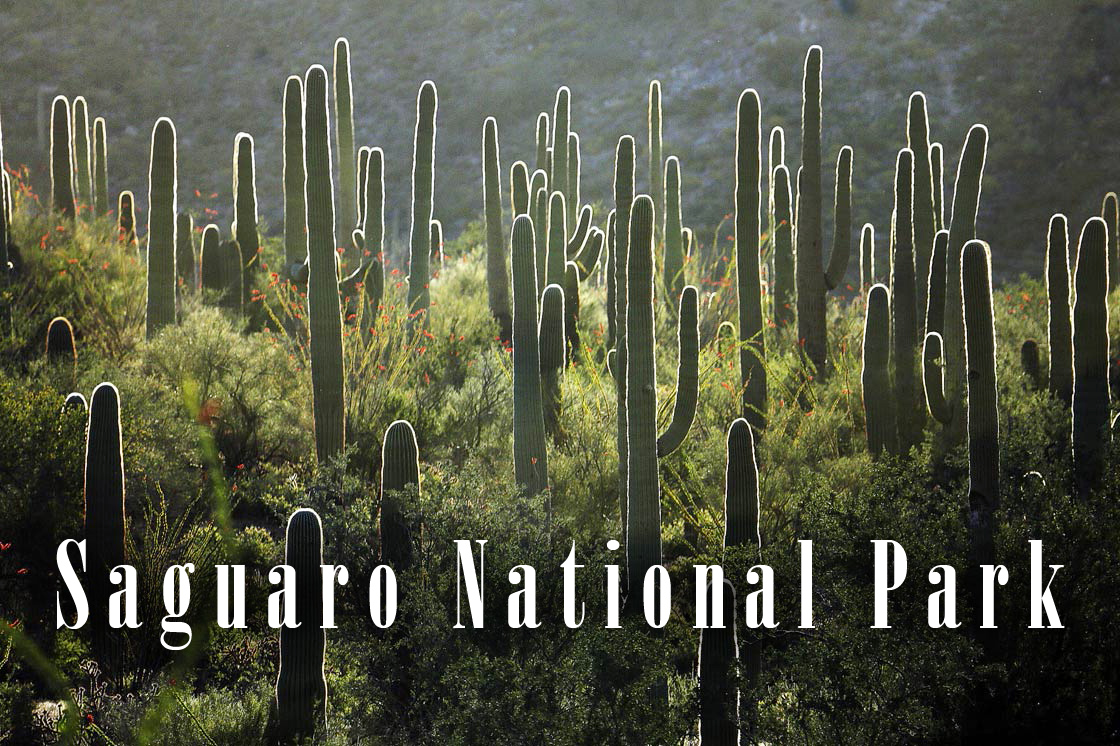Saguaro National Park – a magical trip
Discovering the Hidden Wonders of Saguaro National Park
Saguaro National Park is a US National Park located in the state of Arizona, that covers approximately 92,000 acres and preserves the landscape of the Sonoran Desert. The park is named after the saguaro cactus, which is native to the area and is known for its distinctive shape and size. Saguaro National Park contains two districts, the Tucson Mountain District and the Rincon Mountain District, both of which offer scenic drives, hiking trails, and opportunities for wildlife viewing. The park also contains a variety of other plant and animal species, including diverse landscapes such as canyons, valleys, and rocky foothills.
As the sun rises over the Sonoran Desert, the landscape of Saguaro National Park is bathed in a golden glow, illuminating the towering saguaro cacti that stand like sentinels throughout the park. This breathtaking landscape, with its rugged mountains, vast expanses of desert, and diverse plant and animal life, has captured the imaginations of visitors for generations.
Saguaro National Park is a true wonder of the American Southwest, a testament to the resilience of nature and the power of conservation. Spanning over 92,867.42 acres (37,582.11 ha) in southern Arizona, the park is a sanctuary for a remarkable array of species, from the iconic saguaro cactus, which can reach heights of up to 15 meters (50 feet), to the elusive Gila monster, one of only two venomous lizards in the world.

Saguaro National Park: A Photographer’s Paradise
Beyond its natural wonders, Saguaro National Park is also steeped in a rich cultural and historical legacy, with evidence of human habitation dating back thousands of years. Visitors can explore ancient petroglyphs, witness the ruins of old homesteads, and learn about the diverse communities of people who have called this region home, from the Hohokam and Tohono O’odham peoples to the Spanish explorers who first set foot in the area.
Whether you’re a seasoned hiker, a wildlife enthusiast, or simply seeking a moment of tranquility in one of the most stunning landscapes in the United States, Saguaro National Park has something to offer. With over 165 kilometers (100 miles) of hiking trails, two developed campgrounds, and countless opportunities for wildlife viewing and stargazing, the park is a must-see destination for anyone visiting the American Southwest.
So come, explore the wonders of Saguaro National Park, and discover for yourself the breathtaking beauty and remarkable history that make this one of the most awe-inspiring places on Earth.
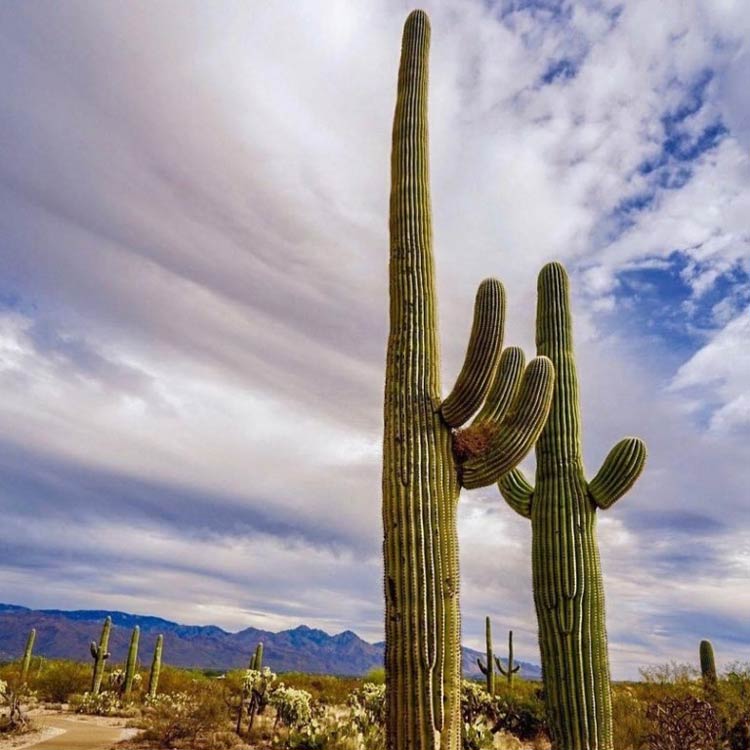
Location
Saguaro National Park is located in southern Arizona, in the vicinity of the city of Tucson. The park is comprised of two separate districts, the Tucson Mountain District to the west of Tucson and the Rincon Mountain District to the east.
Saguaro National Park is a US National Park located in southern Arizona, near the city of Tucson.
Basic facts about the park
- Size
The park covers an area of approximately 92,867.42 acres (37,582.11 ha) - Established
Saguaro National Park was established as a National Monument on March 1, 1933, and redesignated as a National Park on October 14, 1994. - Purpose
The park was created to protect and preserve the unique and fragile Sonoran Desert ecosystem, including its iconic saguaro cacti, as well as to provide opportunities for visitors to experience and learn about the natural and cultural resources of the region. - Location
The park is located in southern Arizona, in the vicinity of the city of Tucson. It is comprised of two separate districts, the Tucson Mountain District to the west of Tucson and the Rincon Mountain District to the east. - Climate
The park is located in the Sonoran Desert, which is characterized by hot, dry summers and mild, cool winters. Most precipitation falls between July and September in the form of monsoon storms. - Wildlife
Saguaro National Park is home to a diverse array of wildlife, including mammals, birds, reptiles, and insects, as well as many species of native plants and wildflowers. - Activities
The park provides a range of recreational opportunities, including hiking, wildlife viewing, and scenic drives. There are also ranger-led interpretive programs and educational opportunities available for visitors of all ages.

History and name of the Park
Saguaro National Park was established as a National Monument on March 1, 1933 by President Herbert Hoover and was re-designated as a National Park on October 14, 1994 by President Bill Clinton.
The park was named after the iconic saguaro cactus, which is native to the Sonoran Desert and is found in abundance throughout the park. The saguaro is an important symbol of the American Southwest and is known for its distinctive shape and size. The park was created to protect and preserve this unique and fragile desert ecosystem, as well as to provide opportunities for visitors to experience and learn about the natural and cultural resources of the region.
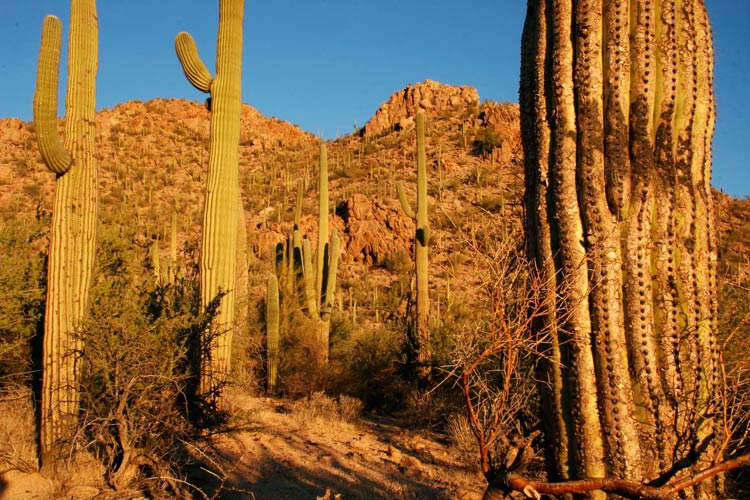
Geography
Saguaro National Park is located in southern Arizona, in the Sonoran Desert. The park covers an area of 92,867 acres (37,582 ha) and includes two separate districts, the Tucson Mountain District and the Rincon Mountain District. The geography of the park is diverse and includes a range of landscapes, including mountains, valleys, canyons, and plains.
The park is situated at an elevation ranging from 2,180 to 4,687 feet (664 to 1,429 m) above sea level. Elevations within the Rincon Mountain District vary from 2,670 to 8,666 feet (814 to 2,641 m). The area receives low amounts of rainfall, with most precipitation falling between July and September in the form of monsoon storms.
The vegetation of the park is characteristic of the Sonoran Desert and includes the saguaro cactus, as well as other cacti, shrubs, and trees, such as the palo verde, creosote bush, and ocotillo. Wildlife in the park includes a variety of mammals, birds, reptiles, and insects, as well as many species of native plants and wildflowers.
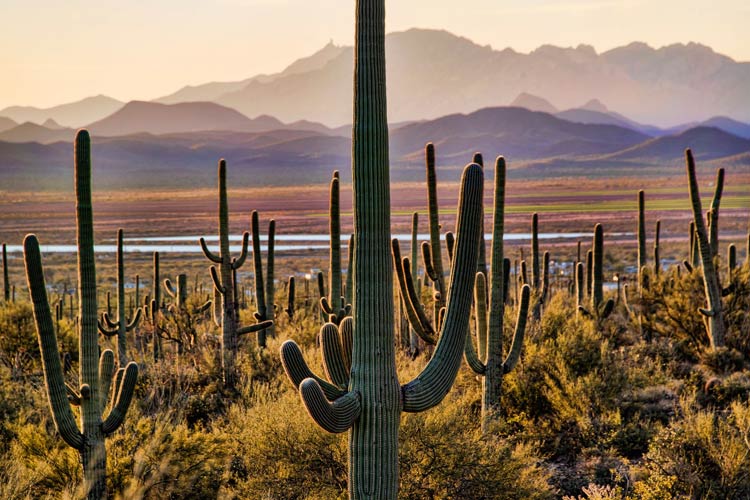
Features of the park
Saguaro National Park is known for its stunning natural beauty and diverse landscape, which includes:
- Mountains
The park contains two mountain ranges, the Tucson Mountains and the Rincon Mountains, with elevations ranging from 2,180 to 4,687 feet (664 to 1,429 m) above sea level. Elevations within the Rincon Mountain District vary from 2,670 to 8,666 feet (814 to 2,641 m). - Canyons
The park contains a number of canyons and valleys, including the iconic King Canyon and Tanque Verde Canyon, that provide scenic views and opportunities for hiking. - Cacti Forests
The park is home to vast forests of saguaro cacti, which can grow up to 60 feet (18 meters) tall and live for up to 200 years. - Desert Scenery
The park encompasses a wide range of desert landscapes, including rocky foothills, plains, and washes, that provide scenic views and opportunities for wildlife viewing. - Hiking Trails
Saguaro National Park contains over 165 miles (265 km) of hiking trails that range from easy nature walks to challenging backcountry treks. - Wildlife
The park is home to a diverse array of wildlife, including mammals such as the desert bighorn sheep, pronghorn antelope, and javelina; birds such as the Gila woodpecker, cactus wren, and roadrunner, reptiles such as rattlesnakes, gila monsters, and desert tortoises (Gopherus agassizii).
These are just some of the many features of Saguaro National Park, which provides visitors with opportunities to experience and explore the unique natural beauty of the Sonoran Desert.
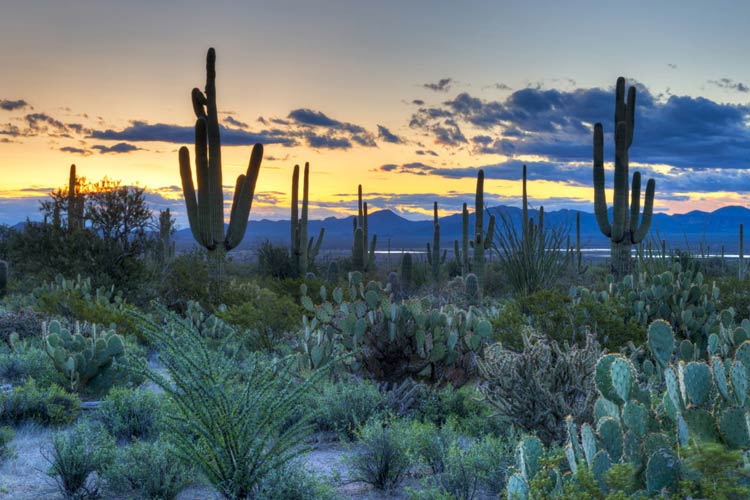
Geology
The geology of Saguaro National Park is shaped by the processes that have shaped the Sonoran Desert region over millions of years. Some of the key geologic features of the park include:
- Volcanic rocks
The park is situated on the southwestern edge of the Tucson Basin, which is surrounded by a ring of volcanic mountains. Volcanic rocks such as basalt and andesite can be found throughout the park, including in the form of cinder cones, lava flows, and volcanic plugs. - Sedimentary rocks
Sedimentary rocks, including sandstone and conglomerate, are also present in the park, forming the foothills and valleys that provide habitat for a wide range of plant and animal species. - Uplift and erosion
The park’s mountain ranges were formed through a combination of uplift and erosion. The uplift of the region, caused by geological processes such as tectonic activity, created the elevated landscape that is now preserved in the park. Erosion has shaped the landscape over millions of years, creating canyons, valleys, and washes. - Landscapes
The unique landscapes of Saguaro National Park, including mountains, valleys, canyons, and plains, are the result of a combination of geological processes and the erosive forces of wind and water.
These geologic features provide a rich and diverse landscape that supports a wide range of plant and animal species and provides visitors with opportunities to explore and learn about the geologic history of the Sonoran Desert.
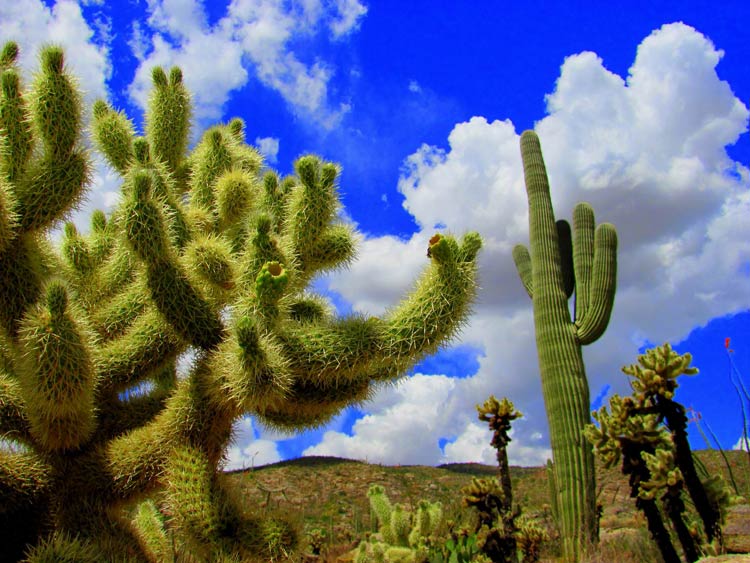
Climate
The climate of Saguaro National Park is characterized by hot, dry summers and mild, cool winters. The park is located in the Sonoran Desert, which is one of the hottest deserts in North America. Some specific features of the climate include:
- Temperatures
Summer temperatures in the park can reach over 100°F (38°C), while winter temperatures can range from the high 40s to low 60s°F (8-15°C). - Rainfall
The park receives most of its precipitation in the form of monsoon storms between July and September. Annual precipitation in the park ranges from about 8-12 inches (20-30 cm). - Humidity
Humidity levels in the park are low year-round, with the relative humidity often dropping below 10% during the summer months. - Wind
Wind is a common feature in the park, particularly in the spring and fall, when gusts can reach over 40 mph (64 kph). - Sun
The park is located at a high elevation, and visitors should be prepared for intense sunlight and UV exposure, particularly during the summer months.
Overall, the climate of Saguaro National Park is arid and hot, and visitors should be prepared for extreme temperatures and exposure to the elements, particularly during the summer months.
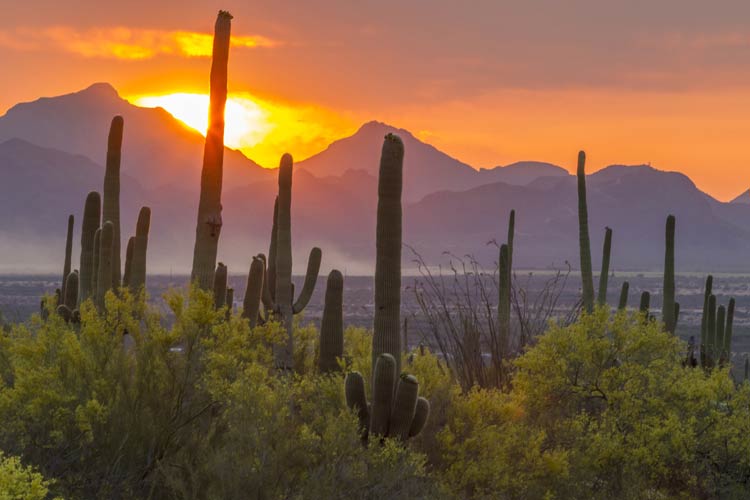
Flora in Saguaro National Park
Saguaro National Park is home to a diverse array of plant life, including a variety of cacti, wildflowers, shrubs, and trees. Some of the key species of flora found in the park include:
- Saguaro Cactus
The saguaro cactus (Carnegiea gigantea) is the iconic symbol of the Sonoran Desert and is the main attraction of Saguaro National Park. These giant cacti can grow up to 50 feet (15 meters) tall and can live for more than 200 years. - Ocotillo
The ocotillo (Fouquieria splendens) is a spiky shrub that is commonly found in the park. It can grow up to 20 feet (6 meters) tall and is known for its bright red flowers, which bloom in the spring. - Cholla Cactus
The cholla cactus (Cylindropuntia spp.) is a type of cactus that is common in the park. It is known for its dense clusters of spiky, barrel-shaped segments and its ability to “jump” onto unsuspecting passersby. - Ironwood Tree
The ironwood tree (Olneya tesota) is a slow-growing tree that is found in the park’s washes and canyons. It is known for its hard, dense wood, which has a rich, reddish color and is highly valued by local Native American tribes for its use in tool-making. - Wildflowers
Saguaro National Park is home to a variety of wildflowers, including the fairy duster (Calliandra eriophylla), the Mexican gold poppy (Eschscholzia mexicana), and the desert marigold (Baileya multiradiata). These flowers bloom in the spring, adding vibrant color to the desert landscape.
These are just a few of the many species of flora found in Saguaro National Park. The park’s diverse array of plant life provides essential habitat for a wide range of wildlife species, including birds, reptiles, mammals, and insects.
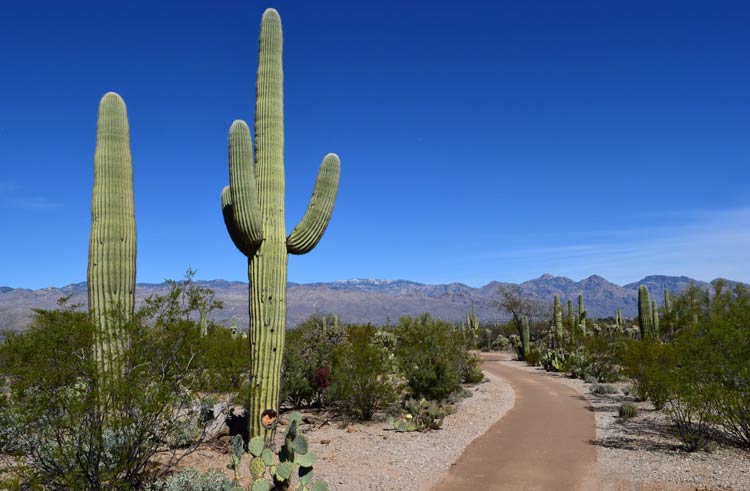
Saguaro (Carnegiea gigantea)
The Saguaro (Carnegiea gigantea) is a species of cactus that is native to the Sonoran Desert in the southwestern United States and northern Mexico. It is the largest cactus species in the United States and is an iconic symbol of the American Southwest. Some key features of the Saguaro cactus include:
- Size
Saguaros can grow up to 50 feet (15 meters) tall and can weigh up to several tons. - Life span
Saguaros can live for over 200 years. - Arms
Saguaros typically have 2-4 arms that grow out from the main trunk of the cactus. These arms develop only after the cactus has reached a certain age (typically between 50 and 75 years) and are a sign of maturity. - Flowers
Saguaros produce large, white flowers that bloom at night during the spring and early summer. The flowers are pollinated by nocturnal insects, including bats, moths, and bees. - Fruit
After flowering, Saguaros produce a juicy, red fruit that is an important food source for a variety of wildlife, including birds and mammals.
The Saguaro cactus is a keystone species in the Sonoran Desert, providing essential habitat and food for a wide range of wildlife. It is also an important cultural symbol for the Native American tribes of the Southwest, who have used the cactus for food, medicine, and other purposes for thousands of years.
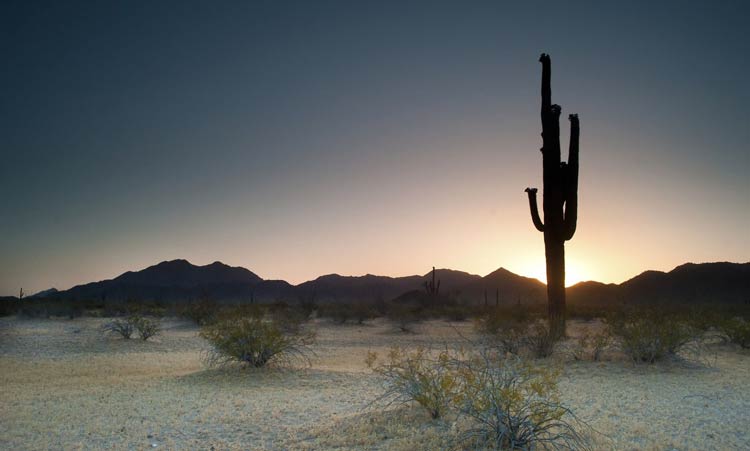
Fauna in Saguaro National Park
In addition to its diverse array of plant life, Saguaro National Park is also home to a variety of wildlife species, including birds, reptiles, mammals, and insects. Some of the key species of fauna found in the park include:
- Bighorn Sheep
The desert bighorn sheep (Ovis canadensis nelsoni) is a type of wild sheep that is native to the American Southwest. Bighorn sheep are known for their impressive agility and climbing ability and can often be seen scaling steep cliffs and canyons in the park. - Gila Monster
The Gila monster (Heloderma suspectum) is a venomous lizard that is native to the Sonoran Desert. It is one of only two venomous lizards in the world and is known for its bright, colorful skin and slow, lumbering movements. - Javelina
The javelina (Pecari tajacu) is a type of wild pig that is native to the Sonoran Desert. Javelinas are social animals and are often seen in groups in the park. - Desert Tortoise
The desert tortoise (Gopherus agassizii) is a species of turtle that is native to the Sonoran Desert. Desert tortoises are slow-moving and can often be seen basking in the sun or foraging for food in the park. - Gambel’s Quail
The Gambel’s quail (Callipepla gambelii) is a species of bird that is native to the American Southwest. Gambel’s quail are known for their distinctive “top-knot” of feathers and their high-pitched call.
These are just a few of the many species of fauna found in Saguaro National Park. The park’s diverse array of plant and animal life provides essential habitat for a wide range of species and supports a complex food web that is an important part of the Sonoran Desert ecosystem.
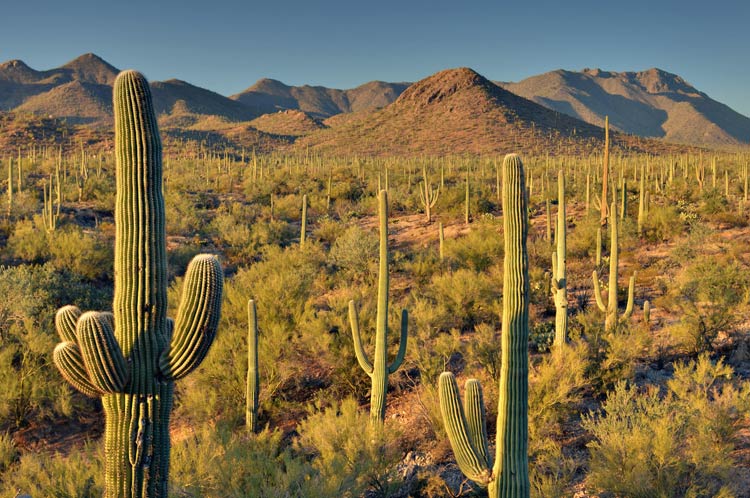
Tourism and tourist main attractions in the park
Saguaro National Park is a popular tourist destination and attracts visitors from around the world. Some of the main attractions in the park include:
- Scenic drives
The park features several scenic drives that offer breathtaking views of the Sonoran Desert and the surrounding mountains. - Hiking trails
Saguaro National Park features over 165 miles (266 km) of hiking trails that range from easy nature walks to challenging backcountry hikes. Some of the most popular trails in the park include the Douglas Spring Trail, the Cactus Forest Trail, and the Mica View Trail. - Wildlife viewing
The park is home to a diverse array of wildlife, including bighorn sheep, javelinas, desert tortoises, and many species of birds. Visitors can enjoy wildlife viewing opportunities throughout the park, either on their own or as part of a guided tour. - Ranger-led programs
The park offers a variety of ranger-led programs and activities, including guided walks, campfire programs, and stargazing events. - Picnicking
The park features several picnic areas that offer stunning views of the surrounding landscape and provide a great place to relax and enjoy a meal. - Photography
Saguaro National Park is a popular destination for photographers, who come to capture images of the towering saguaro cacti, dramatic mountain landscapes, and diverse array of wildlife.
These are just a few of the many attractions and activities available in Saguaro National Park. Whether you’re a nature lover, hiker, birdwatcher, or simply looking for a place to relax and enjoy the beauty of the Southwest, Saguaro National Park is the perfect destination.
Tucson Mountain District
The Tucson Mountain District of Saguaro National Park is located in the western part of the park and covers an area of approximately 60,690 acres (24,588 hectares). The Tucson Mountain District is characterized by its rugged terrain, including rolling hills and deep canyons, and is known for its stunning sunsets and panoramic views of the surrounding mountains and deserts.
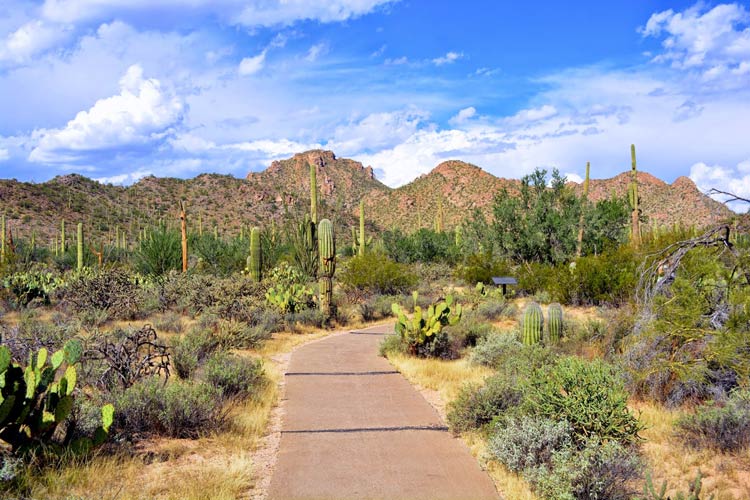
How To Reach To Saguaro National Park?
Saguaro National Park is located in southern Arizona, and there are several ways to reach the park depending on where you’re coming from and which part of the park you want to visit.
If you’re flying in, the nearest major airport is Tucson International Airport (TUS), which is about a 30-minute drive from the park. From the airport, you can rent a car or take a taxi or shuttle service to the park.
If you’re driving, there are two main entrances to the park: the Tucson Mountain District on the west side of the park and the Rincon Mountain District on the east side. Both districts are accessible via paved roads, but note that some of the park’s backcountry roads may require a high-clearance, four-wheel-drive vehicle.
If you’re coming from Tucson, you can reach the Tucson Mountain District by taking Interstate 10 west to the Speedway Boulevard exit, then following Speedway Boulevard west until it becomes Gates Pass Road. From there, follow the signs to the park.
To reach the Rincon Mountain District, take Interstate 10 east to the Houghton Road exit and head south on Houghton Road until it dead-ends at the park entrance.
Alternatively, you can take public transportation to the park. Sun Tran, Tucson’s public transportation system, offers bus service to both the Tucson Mountain and Rincon Mountain Districts. However, note that the park is quite large, so you may need to plan your visit carefully to make the most of your time.

Best Time To Visit Saguaro National Park
The best time to visit Saguaro National Park depends on what you want to see and do, as well as your tolerance for heat and crowds. Here are some factors to consider when planning your visit:
- Weather
Saguaro National Park is located in a desert climate, which means that summers are hot and dry, with daytime temperatures often exceeding 100 degrees Fahrenheit (38 degrees Celsius). Winters are mild and pleasant, with daytime temperatures in the 60s and 70s Fahrenheit (15-25 degrees Celsius) and cool nights. If you want to avoid the extreme heat, plan to visit in the winter or early spring (December through March). - Wildflowers
If you’re interested in seeing the park’s wildflowers in bloom, plan to visit in the spring (March through May). This is when many of the park’s cacti, including the saguaro, bloom with brightly colored flowers. - Crowds
Saguaro National Park is a popular destination, particularly during the winter months when many snowbirds flock to the area to escape colder climates. If you want to avoid the crowds, consider visiting in the summer or fall (June through November). - Outdoor activities
Saguaro National Park offers a range of outdoor activities, including hiking, biking, and horseback riding. If you’re planning on hiking or doing other strenuous activities, it’s best to visit in the cooler months when temperatures are more moderate.
The best time to visit Saguaro National Park is in the winter or early spring when temperatures are mild, crowds are smaller, and the park’s wildflowers are in bloom. However, if you can handle the heat, summer and fall can also be good times to visit.

Saguaro National Park in numbers
Here are some statistics about Saguaro National Park:
- Total area: 92,867.42 acres (37,582.11 ha)
- Elevation: 2,180 to 4,687 feet (664 to 1,429 m); elevations within the Rincon Mountain District vary from 2,670 to 8,666 feet (814 to 2,641 m)
- Number of visitor centers: 2 (Rincon Mountain District and Tucson Mountain District)
- Number of hiking trails: Over 165 kilometers (100 miles) of trails for hiking, backpacking, and horseback riding
- Number of campgrounds: 2 developed campgrounds, with a total of 69 individual campsites
- Number of picnic areas: 8 picnic areas
- Number of species of plants: Over 1,400 species of plants, including the iconic saguaro cactus
- Number of species of wildlife: Over 60 species of mammals and over 250 species of birds
These numbers give a general idea of the size and diversity of Saguaro National Park. However, the park continues to be a dynamic and ever-changing environment, with new species being discovered and changes to the landscape and ecosystem happening all the time.

Interesting facts about Saguaro National Park
Saguaro National Park is a unique and fascinating destination that offers a wealth of interesting facts and features. Here are a few:
- The saguaro cactus
The saguaro cactus (Carnegiea gigantea) is the tallest cactus species in the world, reaching heights of up to 50 feet (15 meters). The saguaro is also an important part of the Sonoran Desert ecosystem, providing food, shelter, and habitat for a variety of wildlife species. - The park’s history
Saguaro National Park was established in 1933 to protect the saguaro cactus and the surrounding Sonoran Desert ecosystem. The park was initially established as a National Monument and was later redesignated as a National Park in 1994. - Biodiversity
Saguaro National Park is home to a diverse array of plant and animal species, including over 1,400 species of plants, 60 species of mammals, and over 250 species of birds. - Night sky
Saguaro National Park is known for its dark skies, which provide some of the best stargazing opportunities in the world. The park was designated an International Dark Sky Park in 2020, recognizing its efforts to preserve and protect its night skies. - Cultural significance
The saguaro cactus holds significant cultural and spiritual significance for many indigenous tribes, including the Tohono O’odham Nation, who consider the cactus a symbol of strength and resilience. - Hiking
Saguaro National Park features over 165 miles (266 km) of hiking trails, ranging from easy nature walks to challenging backcountry hikes. Hiking is one of the most popular activities in the park and offers visitors the opportunity to explore the stunning scenery and diverse wildlife of the Sonoran Desert.
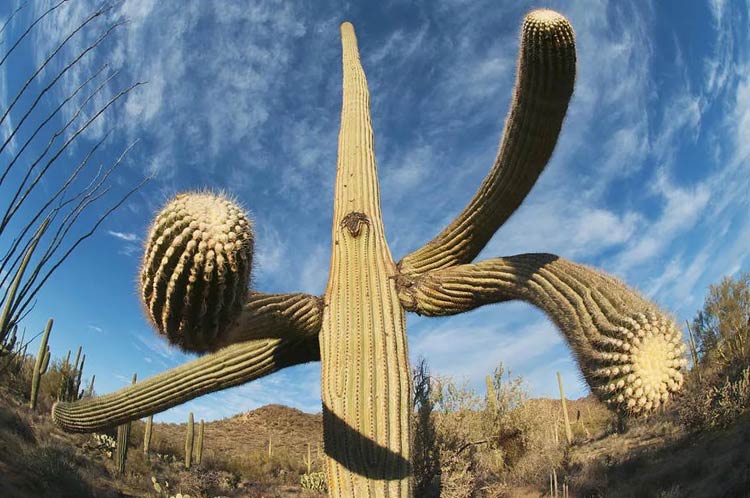
Q&A (questions and answers) about Saguaro National Park
Q: Where is Saguaro National Park located?
A: Saguaro National Park is located in southern Arizona, near the city of Tucson.
Q: What is the purpose of Saguaro National Park?
A: Saguaro National Park was established to protect and preserve the saguaro cactus and the surrounding Sonoran Desert ecosystem.
Q: What kind of wildlife can be found in Saguaro National Park?
A: Saguaro National Park is home to a diverse array of plant and animal species, including over 1,400 species of plants, 60 species of mammals, and over 250 species of birds. Some of the most notable species include the saguaro cactus, the Gila monster (Heloderma suspectum), and the greater roadrunner (Geococcyx californianus).
Q: What are some popular activities in Saguaro National Park?
A: Some popular activities in Saguaro National Park include hiking, wildlife viewing, stargazing, and exploring the park’s cultural and historical sites.
Q: When is the best time to visit Saguaro National Park?
A: The best time to visit Saguaro National Park depends on what you’re interested in seeing and experiencing. The park is open year-round, but temperatures can be quite hot during the summer months. Winter is a popular time to visit, as temperatures are mild and comfortable and the cactus are in bloom.
Q: Is Saguaro National Park accessible to visitors with disabilities?
A: Yes, Saguaro National Park offers accessibility to visitors with disabilities through accessible trails, picnic areas, and restrooms. Visitors should contact the park for more information on accessibility.
